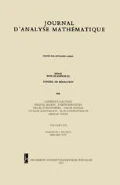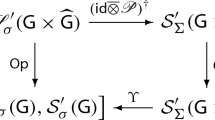Abstract
It is known that if p is a sufficiently large prime, then, for every function f: Zp → [0, 1], there exists a continuous function f′: T → [0, 1] on the circle such that the averages of f and f′ across any prescribed system of linear forms of complexity 1 differ by at most ∈. This result follows from work of Sisask, building on Fourier-analytic arguments of Croot that answered a question of Green. We generalize this result to systems of complexity at most 2, replacing T with the torus T2 equipped with a specific filtration. To this end, we use a notion of modelling for filtered nilmanifolds, that we define in terms of equidistributed maps and combine this notion with tools of quadratic Fourier analysis. Our results yield expressions on the torus for limits of combinatorial quantities involving systems of complexity 2 on Zp. For instance, let m4(α, Zp) denote the minimum, over all sets A ⊆ Zp of cardinality at least αp, of the density of 4-term arithmetic progressions inside A. We show that limp→∞ m4(α, Zp) is equal to the infimum, over all continuous functions f: T2 →[0, 1] with \({\smallint _{{T^2}}}f \geqslant a\), of the integral
Similar content being viewed by others
References
P. Candela and O. Sisask, On the asymptotic maximal density of a set avoiding solutions to linear equations modulo a prime, Acta Math. Hungar. 132 (2011), 223–243.
P. Candela and O. Sisask, Convergence results for systems of linear forms on cyclic groups, and periodic nilsequences, SIAM J. Discrete Math. 28 (2014), 786–810.
E. Croot, The minimal number of three-term arithmetic progressions modulo a prime converges to a limit, Canad. Math. Bull. 51 (2008), 47–56.
E. Croot and V. Lev, Open problems in additive combinatorics, Additive Combinatorics, American Mathematical Society, Providence RI, 2007, pp. 207–233.
L. Corwin and F. P. Greenleaf, Representations of nilpotent Lie groups and their applications, Part 1: Basic theory and examples, Cambridge University Press, Cambridge, 1990.
A. Deitmar and S. Echterhoff, Principles of Harmonic Analysis, Springer, 2009.
T. Eisner and T. Tao, Large values of the Gowers-Host-Kra seminorms, J. Anal. Math. 117 (2012), 133–186.
V. V. Gorbatsevich, A. L. Onishchik and E. B. Vinberg, Foundations of Lie Theory and Lie transformation groups, Springer 1997.
W. T. Gowers, A new proof of Szemerédi’s theorem, Geom./Funct. Anal. 11 (2001), 465–588.
W. T. Gowers and J. Wolf, Linear functions and quadratic uniformity for functions on ZN, J. Anal. Math. 115 (2011), 121–186.
W. T. Gowers and J. Wolf, The true complexity of a system of linear equations, Proc. Lond. Math. Soc. (3) 100 (2010), 155–176.
B. Green and T. Tao, Quadratic uniformity of the Möbius function, Ann. Inst. Fourier (Grenoble) 58 (2008), 1863–1935.
B. Green and T. Tao, The quantitative behaviour of polynomial orbits on nilmanifolds, Ann. of Math. (2) 175 (2012), 465–540.
B. Green and T. Tao, An arithmetic regularity lemma, an associated counting lemma, and applications, An Irregular Mind, Szemerédi is 70, Janos Bolyai Math. Soc., Budapest, 2010, pp. 261–334.
B. Green, T. Tao, and T. Ziegler, An inverse theorem for the Gowers Us+1[N]-norm, Ann. of Math. 176 (2012), 1231–1372.
M. Lazard, Sur les groupes nilpotents et les anneaux de Lie, Ann. Sci. École Normale Sup. (3) 71 (1954), 101–190.
A. Leibman, Polynomial sequences in groups, Journal of Algebra 201 (1998), 189–206.
A. Leibman, Orbit of the diagonal in the power of a nilmanifold, Trans. Amer. Math. Soc. 362 (2010), 1619–1658.
L. Lovász and B. Szegedy, Limits of dense graph sequences, J. Comb. Theory, Ser. B 96 (2006), 933–957.
O. Sisask, Combinatorial properties of large subsets of abelian groups, Ph. D. Thesis, University of Bristol, 2009.
B. Szegedy, Limits of functions on groups, Trans. Amer. Math. Soc., to appear.
B. Szegedy, On higher order Fourier analysis, preprint. arXiv:1203. 2260.
T. Tao and V. Vu, Additive Combinatorics, Cambridge University Press, Cambridge, 2006.
Author information
Authors and Affiliations
Corresponding author
Additional information
This work was supported by the ERC Consolidator Grant No. 617747.
For a finite set X and a function f : X → C, we denote by Ex∈X f (x) the average \(\frac{1}{{\left| {\text{x}} \right|}}\sum {_{x \in X}} f\left( x \right)\) .
Rights and permissions
About this article
Cite this article
Candela, P., Szegedy, B. A continuous model for systems of complexity 2 on simple abelian groups. JAMA 135, 437–471 (2018). https://doi.org/10.1007/s11854-018-0037-8
Received:
Revised:
Published:
Issue Date:
DOI: https://doi.org/10.1007/s11854-018-0037-8



